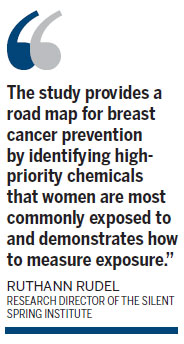Breast cancer linked to 17 ordinary chemicals, US researchers say
Certain chemicals that are common in everyday life have been shown to cause breast cancer in lab rats and are likely to do the same in women, US researchers said on Monday.
The paper in the peer-reviewed journal Environmental Health Perspectives lists 17 chemicals to avoid and offers women advice on how to minimize their exposure.
They include chemicals in gasoline, diesel and other vehicle exhaust, flame retardants, stain-resistant textiles, paint removers and disinfection byproducts in drinking water.
"The study provides a road map for breast cancer prevention by identifying high-priority chemicals that women are most commonly exposed to and demonstrates how to measure exposure," said study author Ruthann Rudel, research director of the Silent Spring Institute.
"This information will guide efforts to reduce exposure to chemicals linked to breast cancer, and help researchers study how women are being affected," she said.
Some of the biggest sources of mammary carcinogens in the environment are benzene and butadiene, which can come from vehicle exhaust, lawn equipment, tobacco smoke and charred food.
Other concerns are cleaning solvents like methylene chloride, pharmaceuticals used in hormone replacement therapy, some flame retardants, chemicals in stain-resistant textiles and nonstick coatings, and styrene which comes from tobacco smoke and is also used to make Styrofoam, the study said.
Carcinogens can also be found in drinking water, researchers said.
Women exposed
"Every woman in America has been exposed to chemicals that may increase her risk of getting breast cancer," said co-author Julia Brody.
"Unfortunately, the link between toxic chemicals and breast cancer has largely been ignored. Reducing chemical exposures could save many, many women's lives."
Brody described the paper as the first to comprehensively list potential breast carcinogens and detail ways for experts to measure them in women's blood and urine.
The study also recommends seven ways for women to avoid these chemicals:

Limit exposure to exhaust from vehicles or generators; don't idle your car; and use electric lawn mowers, leaf blowers and weed whackers instead of gas-powered ones.
Use a ventilation fan while cooking and limit how much burned or charred food you eat.
Do not buy furniture with polyurethane foam. Ask for furniture that has not been treated with flame retardants.
Avoid stain-resistant rugs, furniture and fabrics.
If you use a commercial dry-cleaner, find one that does not use PERC (perchloroethylene) or other solvents. Ask for "wet cleaning."
Use a solid carbon block drinking water filter.
Keep chemicals out of the house by taking off your shoes at the door, using a vacuum with a HEPA (high-efficiency particulate air) filter and cleaning with wet rags and mops.
The research was funded by the Avon Foundation. The Silent Spring Institute is a 20-year-old organization made up of scientists who focus on the environment and women's health.
It is named after the best selling environmental book The Silent Spring by Rachel Carson, who died of breast cancer in 1964, two years after the book was published.
Dale Sandler, chief of epidemiology at the US National Institute of Environmental Health Sciences, described the paper as a "terrific" resource for epidemiologists who study environmental causes of breast cancer.
"This paper is a thorough review of toxicology data and biomarkers relevant to breast cancer in humans," he said.
Agence France-Presse
(China Daily 05/13/2014 page10)














